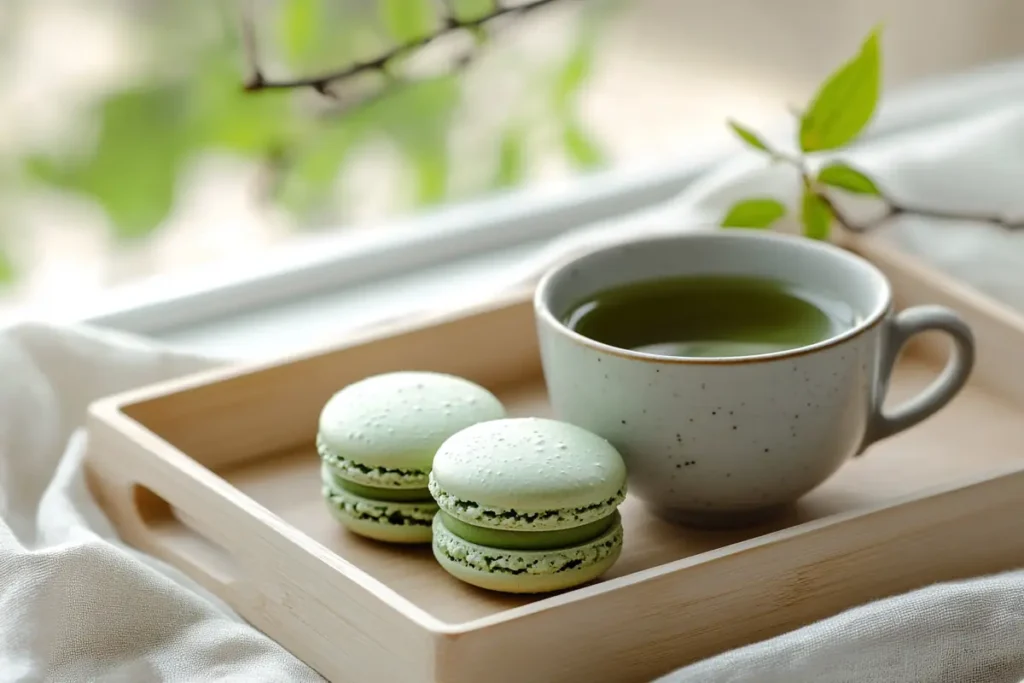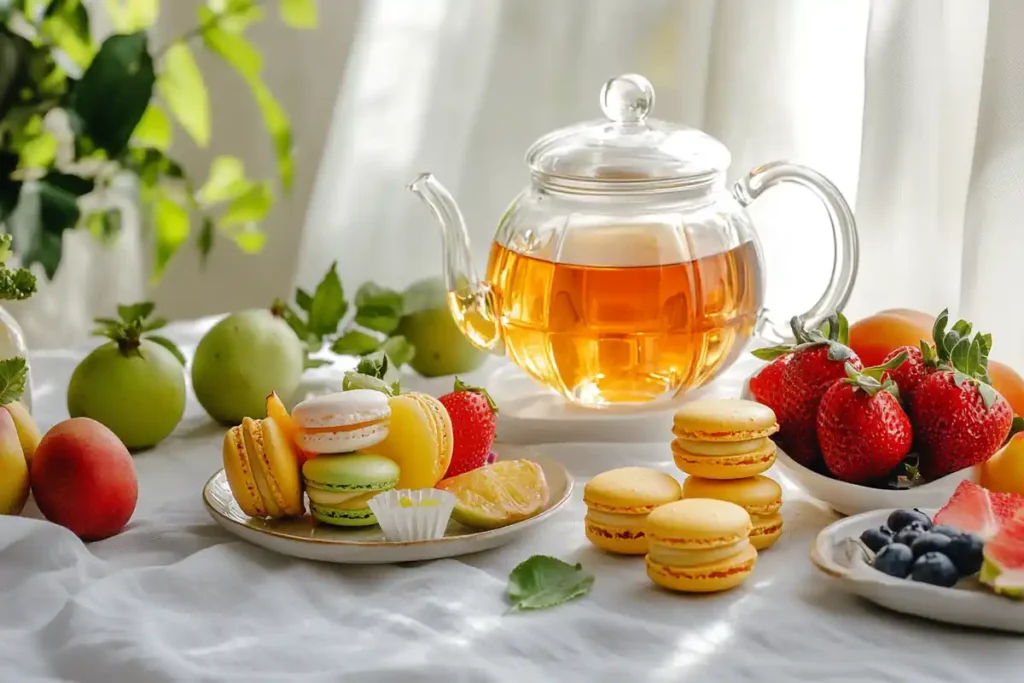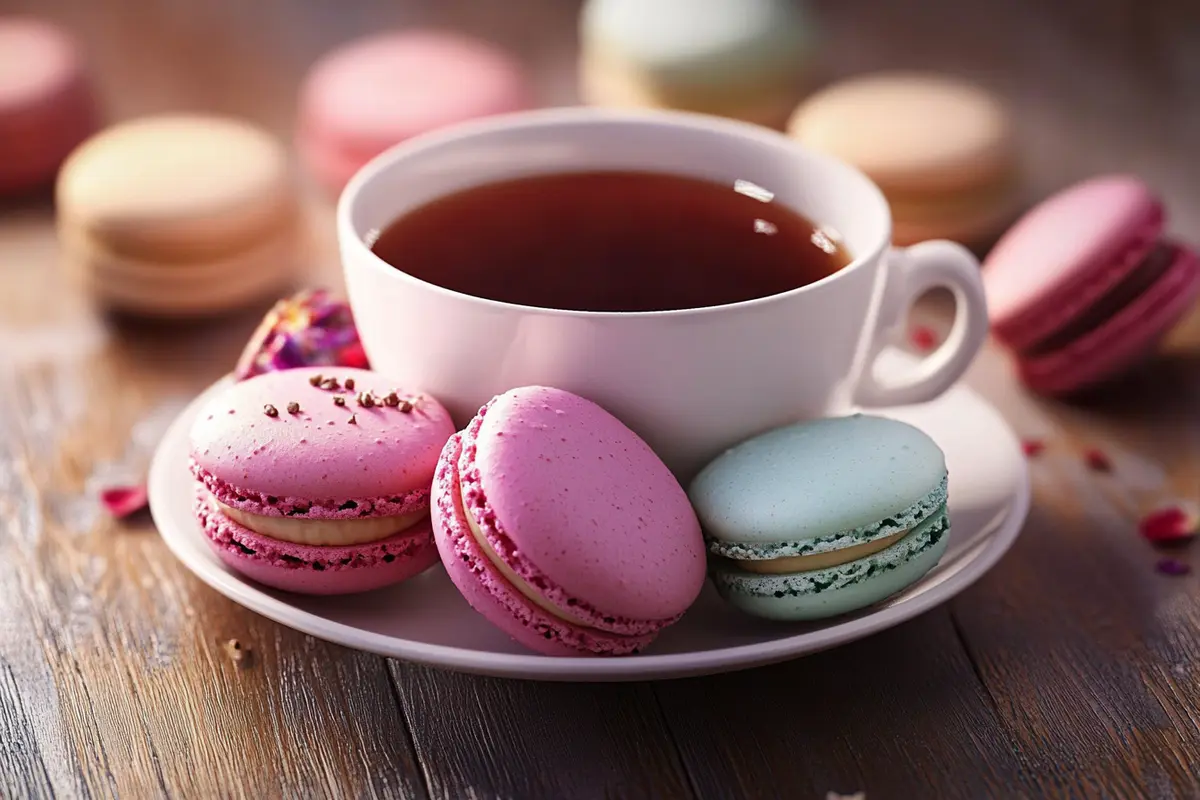Introduction
Do you eat macarons with tea? This delightful pairing has captured the hearts of dessert lovers and tea enthusiasts worldwide. The delicate sweetness of macarons perfectly balances the soothing warmth of tea, creating an unforgettable tasting experience. By pairing macarons with tea, you can explore a wide range of flavor combinations, from classic tea pairings to innovative dessert matches. In this article, we’ll uncover the art of pairing macarons with tea, guide you through hosting the perfect tea party, and share tips for enhancing your tasting experience. Whether you’re a passionate macaron lover, a dedicated tea connoisseur, or simply curious, let’s dive into this sweet and aromatic adventure!
Exploring the Delightful Pairing of Macarons and Tea
The Cultural Significance of Macarons and Tea
Historical Background of Macarons
Do you eat macarons with tea? If so, you’re partaking in a tradition that dates back centuries. Macarons, a renowned French delicacy, have a fascinating history that began during the Renaissance. Originally created in Italy, these sweet confections were introduced to France by Catherine de’ Medici after her marriage to King Henry II in the 16th century. Over time, macarons evolved into iconic French desserts, admired for their delicate texture and vibrant flavors. As baking techniques advanced, they became a symbol of elegance in European aristocratic circles, cementing their place in the world of fine dining.
The Tradition of Tea Drinking
Tea drinking has long been celebrated for its calming and restorative properties. Its roots run deep, from ancient Chinese tea ceremonies, emphasizing mindfulness and respect, to the British tradition of afternoon tea, which fosters community and hospitality. Because of tea’s diverse range of flavors, it pairs wonderfully with desserts like macarons, providing a soothing counterbalance to their sweet richness. This timeless beverage continues to be a staple in cultural rituals around the world, elevating simple social gatherings into cherished traditions.
The Intersection of Macarons and Tea in Culinary Traditions
The idea of pairing macarons with tea might seem modern, but it’s deeply rooted in European tea culture. As tea-drinking customs flourished in France and Britain, luxurious desserts like macarons became an essential part of sophisticated tea gatherings. The delicate sweetness of macarons pairs harmoniously with tea’s earthy, floral, or citrus notes, creating an unforgettable tasting experience. It’s no wonder that tea salons and high-end patisseries continue to offer this classic combination, making it synonymous with refined indulgence.
By blending the elegance of macarons with the soothing tradition of tea, you unlock a culinary experience that has stood the test of time. This pairing is more than a treat—it’s an artful celebration of flavors, perfect for creating memorable taste experiences.
Understanding Macarons
What Are Macarons?
Macarons are delicate, bite-sized French confections made from almond flour, sugar, and egg whites. They have a crisp outer shell and a soft, chewy interior filled with buttercream, ganache, or fruit preserves. Their signature “feet” – the ruffled edge at the bottom – signify a perfectly baked macaron.
Ingredients and Preparation
Making macarons requires precision and patience. Key ingredients include:
- Almond flour: Provides the nutty flavor and smooth texture.
- Powdered sugar: Adds sweetness and helps create the smooth shell.
- Egg whites: Whipped into stiff peaks for structure.
- Granulated sugar: Stabilizes the egg whites when whipped.
- Flavor extracts or colorings: To enhance appearance and taste.
The preparation involves carefully folding ingredients, piping batter into rounds, resting them to form a skin, and baking at the right temperature. Consistency is crucial, as even minor adjustments can affect the final result.
Variations in Flavors and Colors
Macarons come in an array of flavors and colors. Classic choices include vanilla, chocolate, and pistachio, while adventurous bakers create flavors like lavender-honey, matcha, and salted caramel. Food coloring adds vibrant hues, making macarons as visually stunning as they are delicious.
Differences Between Macarons and Macaroons
Though their names sound similar, macarons and macaroons are entirely different treats. Macarons are delicate sandwich cookies, while macaroons are chewy coconut-based cookies. Macarons require precise baking techniques, whereas macaroons are simpler to make, emphasizing coconut flavor and dense texture.
The Art of Tea Pairin
Principles of Pairing Tea with Sweets
Do you eat macarons with tea? If so, understanding the art of tea pairing can elevate your tasting experience to new heights. Pairing tea with macarons is more than just a culinary trend—it’s a thoughtful process that balances or enhances the flavor profiles of both treats. When paired correctly, the natural notes of tea can emphasize the sweetness, richness, or tartness of macarons, creating a harmonious blend that delights the senses. For example, a bold black tea can mellow out the sweetness of chocolate macarons, while a floral herbal tea can enhance the delicate essence of vanilla macarons.
Moreover, successful macaron and tea pairings involve selecting teas with complementary or contrasting flavors, ensuring that each bite and sip creates a well-rounded sensory experience. Complementary flavors amplify shared tasting notes, while contrasting flavors balance intense sweetness with refreshing bitterness. By applying these principles, you can transform a simple snack into an unforgettable culinary adventure that’s both indulgent and elegant. This thoughtful pairing turns any tea break into a delightful ritual worth savoring.
Complementary vs. Contrasting Flavors
Pairing tea with macarons involves either complementary or contrasting flavor matching, depending on the desired taste experience.
- Complementary Pairing: Choosing teas with similar flavor profiles enhances shared notes, creating a unified taste. For example, pairing Earl Grey with vanilla macarons intensifies the macaron’s citrus and floral notes due to the bergamot in the tea. Additionally, a floral herbal tea like lavender can amplify the delicate perfume of lavender-flavored macarons, making each bite more aromatic.
- Contrasting Pairing: On the other hand, pairing opposite flavors creates balance by tempering sweetness or boldness. For instance, green tea, known for its slightly bitter undertones, pairs well with chocolate macarons, which are rich and sweet. This contrast keeps the palate refreshed and prevents the macarons’ sweetness from becoming overwhelming. Similarly, black teas like Assam or Darjeeling cut through the richness of caramel macarons, creating a satisfying balance between robust and sugary flavors.
Enhancing the Tasting Experience
To fully enjoy the pairing of macarons and tea, consider a few expert tips that enhance the overall tasting experience:
- Use Freshly Brewed Tea: Always brew tea fresh for maximum aroma and depth of flavor. Pre-brewed or reheated tea may lose its complexity.
- Alternate Sips and Bites: Take a sip of tea before and after each bite of macaron. This allows the tea to cleanse your palate while enhancing the dessert’s unique notes.
- Consider Temperature Contrasts: Warm tea contrasts beautifully with the cool, creamy filling of macarons, creating a multi-layered sensory experience. Alternatively, iced tea can offer refreshing relief when paired with macarons featuring intense flavors like espresso or salted caramel.
- Experiment with Textures: Tea’s liquid smoothness balances the crisp shell and soft interior of macarons, offering a pleasing contrast in mouthfeel.
With these tips in mind, every tea and macaron pairing can become a unique and enjoyable experience. The right combination can elevate an afternoon tea break into a luxurious indulgence worth savoring.
Recommended Tea and Macaron Pairings
Classic Pairings
Do you eat macarons with tea? Pairing macarons with tea creates a harmonious blend of flavors that is both timeless and satisfying. Traditional pairings highlight familiar tastes while offering a refined and elegant experience. For example, the citrusy notes of Earl Grey perfectly complement vanilla macarons, while the bold richness of black tea balances the sweetness of chocolate macarons. These iconic combinations have earned a special place among dessert lovers and tea enthusiasts worldwide, making them perfect for afternoon tea gatherings, formal events, or even a quiet tea-time indulgence at home.
Earl Grey Tea with Lavender Macarons
Do you eat macarons with tea? If so, Earl Grey tea with lavender macarons is a pairing you can’t miss. The citrusy notes of Earl Grey, infused with bergamot, perfectly complement the floral essence of lavender macarons. While the tea’s aromatic richness adds depth and complexity, the delicate sweetness of the macarons enhances every sip, creating a harmonious balance. Moreover, the subtle lavender perfume intensifies the tea’s floral undertones, resulting in a pairing that feels calm, elegant, and utterly relaxing. This perfect macaron and tea pairing is ideal for afternoon tea gatherings or peaceful tea breaks, making every moment a luxurious indulgence.
Green Tea with Matcha Macarons

Do you eat macarons with tea? If you’re looking for a bold and balanced pairing, consider green tea with matcha macarons. The earthy bitterness of green tea perfectly complements the sweet, creamy filling of matcha macarons, creating a refreshingly balanced flavor profile. While the tea’s mild astringency awakens the palate, the macaron’s delicate sweetness tempers its intensity, resulting in a well-rounded tasting experience. Additionally, the rich umami of matcha amplifies the tea’s herbal undertones, making this combination an ideal choice for tea connoisseurs seeking unique and complex flavor profiles. This pairing brings together traditional Japanese tea culture and modern dessert artistry in a way that is satisfying and memorable.
Black Tea with Chocolate Macarons
Black tea, such as Assam or Darjeeling, brings bold, intense flavors that complement the deep richness of chocolate macarons. Since black tea is naturally robust, it cuts through the macaron’s sweetness, leaving a balanced finish that feels indulgent yet satisfying. Meanwhile, the tea’s malty undertones amplify the macaron’s chocolatey notes, making this combination a favorite for dessert lovers craving something decadent and bold.
Innovative Pairings
For those who enjoy creative culinary adventures, these innovative pairings offer exciting flavor contrasts that push the boundaries of traditional tea-time combinations.
Herbal Teas with Fruity Macarons

Herbal teas like hibiscus, chamomile, or lemon balm bring out the vibrant fruitiness of macarons such as raspberry, lemon, or strawberry. Their bright, tangy notes create a refreshing contrast, especially when the macarons feature tart fruit fillings. Since herbal teas are caffeine-free, they make an ideal pairing for evening gatherings or late-night dessert sessions, ensuring guests can indulge without sacrificing sleep.
Oolong Tea with Pistachio Macarons
The toasty richness of oolong tea pairs beautifully with the nutty sweetness of pistachio macarons. Since oolong tea has complex flavor layers that range from floral to smoky, it mirrors the earthy undertones of pistachios. This creates a smooth, balanced experience that feels sophisticated yet approachable. For an extra-special touch, consider serving lightly roasted oolong to highlight pistachio’s creamy notes, making this pairing a top choice for elegant tea parties or refined dessert tastings.
By thoughtfully combining these classic and innovative pairings, you can create a memorable tea experience that delights the senses and impresses any guest.
Hosting a Macaron and Tea Tasting Event
Planning the Menu
A well-thought-out menu is essential for a successful macaron and tea-tasting event. Consider the following steps when planning:
Selecting a Variety of Macarons
Offer a colorful assortment of macarons featuring classic and unique flavors. This provides guests with a diverse tasting experience. Include sweet, tart, and nutty varieties for maximum flavor contrast.
Choosing Complementary Teas
Select loose-leaf teas known for their aromatic depth. Ensure you have a range of options, including herbal, black, green, and oolong teas, to match your macarons. Provide tasting cards describing the pairing notes for an interactive experience.
Setting the Ambiance
Create an inviting atmosphere that enhances the overall experience of the tasting event.
Table Setting and Decorations
Use an elegant tablecloth, fine china, and delicate glassware to set the mood. Decorate with fresh flowers, candles, or even a vintage tea set. A tiered dessert stand can display macarons beautifully, making them the centerpiece of the table.
Serving Etiquette
Serve tea at the right temperature and replenish it frequently. Use tea strainers for loose-leaf brews, and provide small plates and forks for macarons. Encourage guests to sip and savor slowly, allowing the flavors to unfold naturally.
Frequently Asked Questions
Do You Eat Macarons with Tea?
Absolutely! Macarons and tea are a match made in culinary heaven. The sweetness of macarons perfectly complements the warm, soothing notes of tea. Enjoying them together enhances the tasting experience by balancing the macaron’s rich flavors with tea’s refreshing qualities.
What Are You Supposed to Eat Macarons With?
Macarons pair well with a variety of beverages beyond tea. Consider coffee, hot chocolate, or even sparkling water to cleanse the palate between bites. However, tea remains the most popular pairing due to its aromatic complexity and versatile flavors.
What Are Macarons Paired With?
Macarons can be paired with:
- Teas: Black, green, herbal, and oolong teas complement different macaron flavors.
- Fresh Fruits: Berries like strawberries and raspberries enhance fruity macaron flavors.
- Cheese Platters: Soft cheeses such as brie or mascarpone provide a delightful contrast.
- Dessert Wines (optional): Though not covered here, macarons also pair with select sweet beverages in non-alcoholic variations like sparkling apple cider.
Are Macarons Supposed to Be Eaten Cold?
No, macarons taste best at room temperature. They should be removed from the refrigerator 30 minutes before serving. Chilled macarons may feel too firm, while room-temperature ones offer the perfect balance of a crisp shell and soft, creamy filling.
Conclusion
The Joy of Savoring Macarons with Tea
Do you eat macarons with tea? If not, you’re missing out on one of life’s most delightful culinary experiences. Combining the delicate sweetness of macarons with the soothing warmth of tea transforms an ordinary snack into an elegant sensory experience. The interplay of sweet and savory, crisp and creamy, warm and cool creates a tasting experience that is both indulgent and satisfying. This pairing goes beyond simple enjoyment—it’s a culinary ritual that invites relaxation, mindfulness, and a touch of luxury.
Embracing the Experience
Embrace the art of savoring by setting aside time to truly enjoy macarons with tea. Consider hosting a tea-tasting event with friends or family, featuring beautifully arranged desserts and thoughtfully brewed teas. Take the time to sip and savor each pairing, allowing their unique flavor profiles to unfold. By creating a memorable tea party experience, you’ll enjoy a perfect pairing that’s both fun and elegant.
Encouraging Exploration of Flavors
Don’t be afraid to experiment with macaron flavors and tea varieties. Try unexpected pairings like spicy chai with caramel macarons or jasmine tea paired with citrus-flavored sweets. The possibilities are endless when you mix and match to discover new favorites. Every pairing can unlock unique tasting experiences, making your tea time more enjoyable and exciting.
Whether you’re hosting an elegant gathering or treating yourself, macarons and tea offer a memorable taste adventure. So why wait? Indulge in this perfect pairing and let your taste buds savor the ultimate fusion of sweet and aromatic delights.

